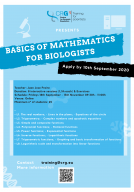 Basics of Mathematics 2020
Basics of Mathematics 2020

Registration HERE
Basics of Mathematics 2020
Modern Biology is becoming an increasingly quantitative discipline that requires a high degree of interdisciplinary interactions among scientists. Biologists usually face the most difficult part of interdisciplinary collaborations since the level of mathematics needed to develop a fruitful discussion is relatively high. The goal of this course is to introduce biologists to the most basic concepts of mathematics that are needed for the study of Calculus and to acquire a basic understanding of the language of mathematics to ease interdisciplinary communication.
Teacher: Juanjo Fraire Zamora
Aims and approach: In 8 (1,5h each), participants will be guided through basic concepts of introductory mathematics that are the foundation for the study of Calculus. Instructor will introduce the topics with examples and exercises of biological applications when possible.
Schedule: Fridays, 18th September- 13th November 2020, 9:30- 11:00
Venue: Zoom and CRG Moodle
Maximum nº participants: 25
Audience: Biologists with very basic training in mathematics
Application deadline: 10th September 2020
Calendar:
| Session | Title | Date |
| 1 | The real numbers; - Lines in the plane; - Equation of the circle | 18/09/2020 |
| 2 | Trigonometry; - Complex numbers and quadratic equations | 2/10/2020 |
| 3 | Simple and composite functions | 9/10/2020 |
| 4 | Polynomial functions; - Rational functions | 16/10/2020 |
| 5 | Power functions; - Exponential functions | 23/10/2020 |
| 6 | Inverse functions; - Logarithmic functions | 30/10/2020 |
| 7 | Trigonometric functions; - Graphing and basic transformation of functions | 6/11/2020 |
| 8 |
Logarithmic scale and transformation into linear functions |
13/11/2020 |
At the end of the course
The students will acquire basic math vocabulary and tools for trigonometry and basic functions (including exponential and logarithmic) and their graphical properties and biological relevance. The students will be able to translate graphs or models into verbal descriptions of biological significance.
